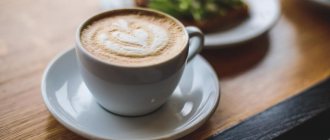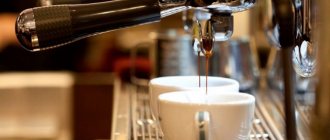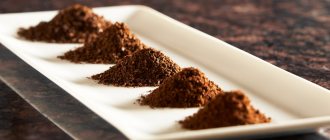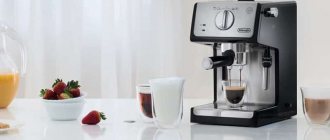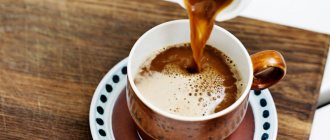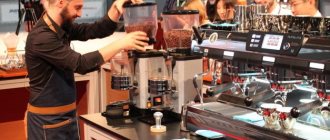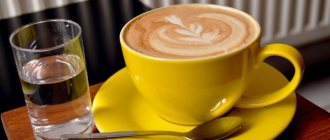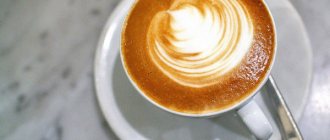What is a coffee card
The coffee list is essentially the same menu as in cafes and restaurants, only all sorts of variations of drinks come first in the coffee shop list. The map of your establishment can contain any number of positions - from tens to hundreds, but, in any case, you need to start with the most popular and simple drinks.
A small assortment is not a minus for the establishment. It’s hard to surprise with a menu with a huge selection, and many successful coffee shops offer 10-15 types of coffee on their menu, but even respectable restaurants can envy the quality of these drinks
Clarification.
You don't have to limit yourself to just drinks when creating a map. Despite the name “coffee shop”, it would be appropriate to indicate other items on the card, for example, desserts and snacks.
How to make cappuccino coffee using a coffee machine
The type of cappuccino you get in a coffee machine is not affected by its power, volume and number of stations (the station is the part of the coffee machine where the holder (portafilter) is installed, plus the holder itself with the filter).
The type of machine and the type of cappuccino maker, as well as the possibility of warming up the mugs, have a direct impact on the taste and quality. For those who love cappuccino, but do not know anything about making it, you can give preference to a fully automatic coffee machine. But the most delicious cappuccino is obtained in a semi-automatic machine, where all operations must be controlled.
The quality of the drink's foam depends on the type of cappuccino maker. As with a coffee machine, they come in automatic and semi-automatic varieties. Professionals recommend using a semi-automatic option, where the foam is whipped manually, but this is done using hot steam from a cappuccino machine.
It is important that the container is warmed up before pouring espresso into the cup. To do this, the upper part of the coffee machine is heated, since cups for the drink need to be placed in them.
Also interesting: mochaccino recipe
What should be included in a coffee card
Cards in coffee shops are drawn up according to one of two basic principles:
- indicate different types of coffee drinks with a list of the ingredients from which they are prepared;
- also indicate the range of drinks, but with the possibility for the visitor to choose specific ingredients and their proportions from which the drink will be prepared.
The first option is more convenient for coffee-to-go establishments, where the barista does not have time to answer clarifying questions from visitors about the types of coffee and other features of the drinks. The second option is suitable for atmospheric establishments with higher prices than in mini-coffee shops.
Beverages
The coffee list of almost any coffee shop can be divided into four sections:
- black coffee (espresso, ristretto, Americano);
- coffee with milk is usually the most popular item in any establishment (cappuccino, latte, flat white);
- signature drink options - the opportunity to come up with special items for which customers will return again and again;
- an alternative to the usual drinks prepared in a coffee machine: coffee in a cezve, in a French press, in an Aeropress.
Complex types of drinks are usually accompanied by a detailed description and photo. Clarification.
If you have recently opened, it is enough to include only the first two items in your coffee list: black coffee and coffee with milk. The remaining items can be added later or dispensed with altogether if you do not plan to expand the range.
Exclusive offers and promotions
It is appropriate to announce exclusive offers and promotions from your establishment on the last page. Offers can be anything - discounts on certain items, complex signature cocktails, caffeine-free drinks and much more - the main thing is that the coffee shop’s promotions are interesting to your target audience.
Dessert
The list of desserts can be indicated after listing the main items - all possible options for coffee drinks. For the convenience of guests who adhere to a healthy lifestyle and watch their figure, supplement the description of each dessert with a list of its ingredients and indicate the calorie content of the serving.
Clarification.
If your coffee shop also offers snacks to visitors, list the range of dishes after desserts.
Product name: Coffee drink with milk
Recipe number: 253
Name of the collection of recipes: Collection of technological standards, recipes for dishes and culinary products for preschool educational institutions, in 2 parts - ed. Assoc. Korovka L. S., associate professor Dobroserdova I.I. et al., Ural Regional Nutrition Center, 2004
| name of raw materials | Consumption of raw materials and semi-finished products | ||
| from 1-3 years | from 1-3 years | from 3-7 years | from 3-7 years |
| Gross, g | Net, g | Gross, g | Net, g |
| Cereal coffee drink) surrogate), incl. from chicory | 2,4 | 2,4 | |
| Milk with m.d.f. 2.5-3.2% | |||
| Water | |||
| 114Sugar | |||
| Exit |
Chemical composition of this dish (for children from 1-3 years old)
| Nutrients | Miner. substances, mg | Vitamins, mg | ||||||
| Proteins, g | Fats, g | Carbohydrates, g | Energy value, kcal | Ca | Fe | IN 1 | AT 2 | WITH |
| 1,08 | 1,08 | 11,67 | 76,67 | 90,2 | 0,02 | 0,02 | 0,02 | 0,83 |
Chemical composition of this dish (for children from 3-7 years old)
| Nutrients | Miner. substances, mg | Vitamins, mg | ||||||
| Proteins, g | Fats, g | Carbohydrates, g | Energy value, kcal | Ca | Fe | IN 1 | AT 2 | WITH |
| 1,3 | 1,3 | 108,24 | 0,02 | 0,02 | 0,02 |
Cooking technology
When brewing, the coffee drink is placed in an appropriate container, poured with boiling water, stirred, brought to a boil, boiled for 3-5 minutes and allowed to stand for 5-8 minutes. After this, the finished coffee drink is poured into another container through a cloth or sieve. Do not boil the coffee drink for a long time or reheat it repeatedly. Add hot milk and sugar to the brewed, strained coffee drink and bring to a boil.
Supply temperature +60…+65º C.
Quality requirements
Appearance
: coffee drink poured into a glass or cup.
Consistency:
liquid.
Color:
light brown.
Taste:
sweet, with a pronounced taste of coffee drink and boiled milk.
Smell:
aroma of coffee drink and boiled milk.
Technological map No. _3__
Product name: Butter and cheese sandwich
Recipe number: 3
Name of the collection of recipes: Collection of technical standards - Collection of recipes for dishes and culinary products for feeding schoolchildren / Ed. M. P. Mogilny. – M.: DeLi print, 2005.
| name of raw materials | Consumption of raw materials and semi-finished products | ||
| from 1.5-3 years | from 1.5-3 years | from 3-7 years | from 3-7 years |
| Gross, g | Net, g | Gross, g | Net, g |
| Wheat bread (grain bread) or loaf | |||
| Sweet cream cow butter | |||
| Hard cheese | 9,6 | 14,9 | |
| Exit with butter and cheese | 20/4/9 | 30/5/14 |
Chemical composition of this dish (for children from 1.5-3 years old)
| Nutrients | Miner. substances, mg | Vitamins, mg | ||||||
| Proteins, g | Fats, g | Carbohydrates, g | Energy value, kcal | Ca | Fe | IN 1 | AT 2 | WITH |
| 3,61 | 5,4 | 9,75 | 94,48 | 0,33 | 0,02 | 0,01 | 0,14 |
Chemical composition of this dish (for children from 3-7 years old)
| Nutrients | Miner. substances, mg | Vitamins, mg | ||||||
| Proteins, g | Fats, g | Carbohydrates, g | Energy value, kcal | Ca | Fe | IN 1 | AT 2 | WITH |
| 5,06 | 14,62 | 126,6 | 0,47 | 0,03 | 0,03 | 0,19 |
Cooking technology
A slice of bread (loaf) is spread with butter, with rectangular or triangular cheese on top.
Serving temperature 15º C.
Quality requirements
Appearance:
even slices of bread (loaf), spread with butter, topped with rectangular or triangular cheese.
Consistency:
soft.
Color:
cheese, butter and bread (loaf).
Taste:
cheese, butter and bread (loaf).
Smell:
cheese combined with fresh bread (loaf).
Technological map No. _4__
Product name: Boiled beet salad with green peas
Recipe number:53
Name of the collection of recipes: Collection of technological standards, recipes for dishes and culinary products for preschool educational institutions, in 2 parts - ed. Assoc. Korovka L. S., associate professor Dobroserdova I.I. et al., Ural Regional Nutrition Center, 2004
| name of raw materials | Consumption of raw materials and semi-finished products | ||
| from 1-3 years | from 1-3 years | from 3-7 years | from 3-7 years |
| Gross, g | Net, g | Gross, g | Net, g |
| Beet | |||
| Until January 1 | |||
| From January 1 | |||
| Mass of boiled peeled beets | |||
| Canned green peas | |||
| Canned boiled green peas (without liquid part) | |||
| Vegetable oil | |||
| Exit |
Chemical composition of this dish (for children from 1-3 years old)
| Nutrients | Miner. substances, mg | Vitamins, mg | ||||||
| Proteins, g | Fats, g | Carbohydrates, g | Energy value, kcal | Ca | Fe | IN 1 | AT 2 | WITH |
| 0,85 | 3,42 | 3,07 | 12,34 | 0,46 | 0,02 | 0,04 | 3,36 |
Chemical composition of this dish (for children from 3-7 years old)
| Nutrients | Miner. substances, mg | Vitamins, mg | ||||||
| Proteins, g | Fats, g | Carbohydrates, g | Energy value, kcal | Ca | Fe | IN 1 | AT 2 | WITH |
| 1,13 | 4,56 | 4,09 | 16,45 | 0,61 | 0,03 | 0,05 | 4,48 |
Cooking technology
Before opening, consumer packaging of canned products is washed with running water and wiped with a rag.
Vegetables are sorted and washed.
The beets are boiled in their skins and cooled; peeled and cut into strips or chopped in a cold workshop or in a hot workshop on a table for boiled products. Cooking vegetables the day before the day of cooking is not allowed. Canned green peas are boiled in their own juice, the broth is drained and cooled. Mix the vegetables and season with vegetable oil.
Vegetables boiled for salads are stored in the refrigerator for no more than 6 hours at a temperature of plus 4±2°C.
Salads are prepared and dressed immediately before distribution. Undressed salads can be stored for no more than 2 hours at a temperature of plus 4±2 °C. Salads are dressed immediately before serving. Vegetable oil should be used as a salad dressing. Dressed salads can be stored for no more than 30 minutes at a temperature of 4±2 °C. The use of sour cream and mayonnaise for salad dressing is not allowed.
The serving temperature is not lower than +15º C.
Quality requirements
Appearance:
The salad is piled high and seasoned with vegetable oil.
Consistency:
beets
-
soft, juicy, canned green peas - soft.
Color:
raspberry with green splashes of green peas.
Taste:
beets, green peas in combination with vegetable oil, salty.
Smell:
beets, green peas in combination with vegetable oil.
Technological map No. _5__
Filling the card as the cooking complexity increases
The principle “from simple to complex” is effective in any field, including in drawing up a coffee map. To prevent visitors from feeling awkward, at the beginning of the card indicate the most simple and understandable positions for everyone: espresso, cappuccino, Americano. Offer more complex drinks after simple ones, be sure to supplement each item with a description of the ingredients that are included in a particular drink in addition to coffee: for example, cream, honey, alcohol.
Technological map of cappuccino coffee
Like any dish or drink, cappuccino has its own technological map. The card is a standardized document that serves as a kind of instruction for those who prepare cappuccino.
Some people get confused by calling cappuccino a cocktail and not a coffee drink. But this is not the case, because the concentration of espresso here is quite high for a cocktail. In order to prepare cappuccino, you need to brew espresso, heat the milk, and froth some of it using a cappuccino maker.
Proportions (ratio) of coffee and milk in cappuccino. According to the technology, this drink consists of one third espresso, one third milk, 1/3 part milk foam. Sugar or topping can be added as desired.
The milk should be whole, but not dry. The fat content of milk is 3.2 percent. The ideal temperature for milk is 3 degrees above zero.
In order to brew standard espresso, you need: 1 teaspoon of ground coffee and 40 ml of water. To get a spoonful of coffee you need to take 7 grams of beans. And you need to take at least 150 ml of milk, a third of which will turn into foam.
How many calories are in cappuccino coffee: with sugar, without sugar. The calorie content of such a drink is not very high. If a person prefers to drink cappuccino without sugar, then 200 ml of drink accounts for at least 32-50 kcal. With sugar, the calorie content is slightly higher, namely 47-75 kcal. It is impossible to say exactly how many calories are in a particular cup. Because calorie content depends not only on the amount of sugar, but also on the fat content of the milk used, as well as the presence of syrup, chocolate and other possible additives in it.
Where there is less coffee - in latte or cappuccino
Inexperienced coffee lovers, when trying a cappuccino or latte for the first time, may not feel much difference. But in fact, these are two different drinks, and they have significant differences.
The main thing is the amount of milk. Latte is a layered drink in which there is one third more frothed milk, which is why you can’t hear the bitterness of espresso at all. Therefore, some experts argue that latte is not a coffee drink at all, because espresso takes up only a quarter of it.
Similar articles:
- Instant coffee: benefits and harms
- Coffee facts: producing and exporting countries
- Types of coffee at Starbucks: recipes, calorie content, how to make
- Which types of coffee are considered the best: coffee brands
- Secrets of Vietnamese coffee: cost, preparation
Barley coffee recipe.
You need to take 3 teaspoons of barley grains (the larger the grains, the better). It is recommended to wash them thoroughly and dry them completely. Then fry the barley in a very hot frying pan until they darken and the appropriate smell appears. Grind the finished grains in a coffee grinder, pour into a container with water (150-200 ml), bring to a boil and leave for 3-5 minutes. To improve the taste, you can add a spoonful of honey, a pinch of cinnamon or lemon to the drink.
The recipe for surrogate coffee made from acorns is worthy of special attention. The usefulness of such a drink for the child’s body lies, firstly, in the prevention of rickets and scrofula. Ripe fruits selected for autumn are washed, dried, and removed from the shell. Then the acorns, cut into small pieces, are dried in the oven for more than half an hour, crushed in a coffee grinder or blender and prepared like barley, using the method discussed above.
Web sources offer a very interesting alternative to a coffee drink made from the fruit of Jerusalem artichoke (earth pear). Tubers collected in autumn or spring need to be peeled, cut into small pieces, and pour boiling water over them for a few minutes. Then dry and fry in the oven or in a frying pan. Then, according to the principle described a little higher, the Jerusalem artichoke is crushed and boiled. This drink will be useful for all children, but it is especially recommended for those with diabetes. The finished drink needs to be poured into cups and amuse the little ones! Bon appetit!
How to prepare a coffee drink in kindergarten.
1. Savory KEFIR DUMPS INGREDIENTS: ? 1.5 tbsp flour? 1 tbsp kefir? 1 testicle? 3 tbsp. spoons of butter? 2-3 tbsp. l. Sahara? 1/3 teaspoon of soda? 1/4 teaspoon salt? vegetable oil.
Ingredients: Cottage cheese – 500 g. Eggs – 5 pcs. Butter or margarine – 50 g. Raisins – to taste. Zest – from 1 lemon. Semolina – 1 tbsp. spoon with a small pile. Sugar – 100 g. Sour cream – 50 g.
A simple and delicious cupcake without flour or sugar. Now this is the only way I prepare cupcakes! A 3-ingredient recipe that has no analogues... A simple and delicious cake without flour and sugar is my favorite dessert.
Ingredients: 500 g chicken fillet, 300 g all mushrooms (we have champignons), 70 g cheese, 3 tbsp. spoons of cream, 1 onion, salt, pepper to taste. Cut the mushrooms into cubes and fry in vegetable oil with chopped onion, add salt at the end.
This recipe has been tested for years - the best homemade bread I've ever tried! Ingredients: - 650 ml warm water - 2.5 tsp. dry yeast - 1 tsp. sugar - 2 tsp. salt - 1.
Drinks based on kindergarten recipes.
What do kids usually drink in kindergarten?! That's right: milk! And also cocoa, vitamin tea and even coffee for breakfast. Now we will look into the kitchen of a preschool educational institution to learn how to prepare the right children's drinks.
In addition to water, it is very important for children to learn to drink other healthy drinks. Kvass or gas-water are not included in this list. But juice, cocoa with milk and a coffee drink are very often on the kindergarten menu.
It’s worth saying right away that the coffee drink is not at all Arabica or even instant freeze-dried coffee in our classical understanding. Kindergarten “coffee” made from barley grains, which are previously roasted and have a very aromatic smell of freshly baked goods. This kind of “coffee” is very useful for the baby’s immune system and does not at all disrupt glycemic metabolic processes or have an effect on the heart and blood vessels.
In kindergartens in the Urals, Siberia and the Far East, children are also given vitamin tea for the second breakfast. It is prepared from rose hips. And it has long been clear that this is a record holder and a good supplier of vitamin C to our body. This is the tea we will learn to brew correctly. Well, as for cocoa and coffee, I think anyone can make it. I’ll just show you the technology cards for their production.
Total cooking time – 8 hours 0 minutes Active cooking time – 0 hours 15 minutes Price – very economical Calories per 100 g – 7 kcal Number of servings – 5 servings
